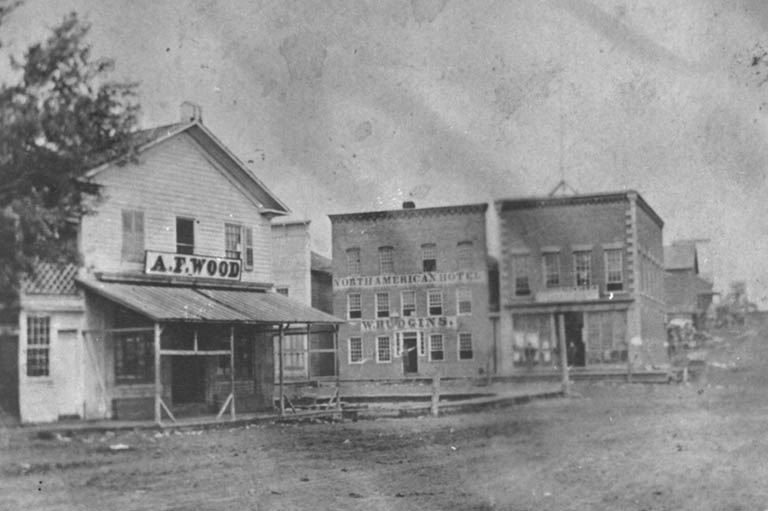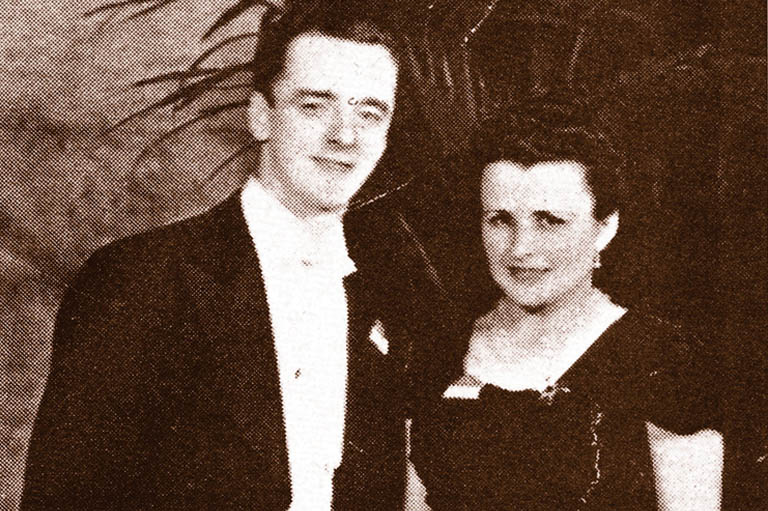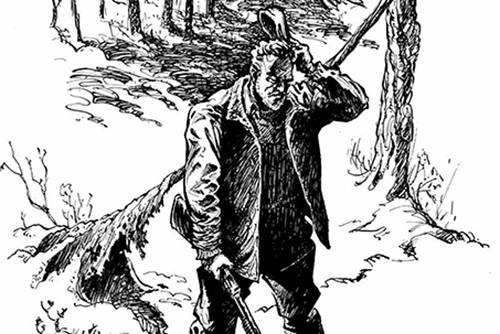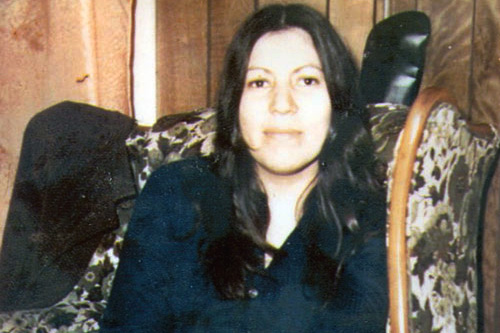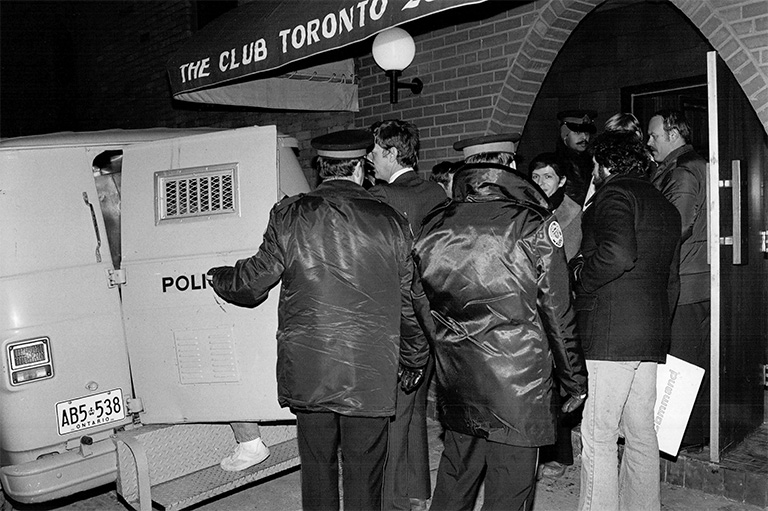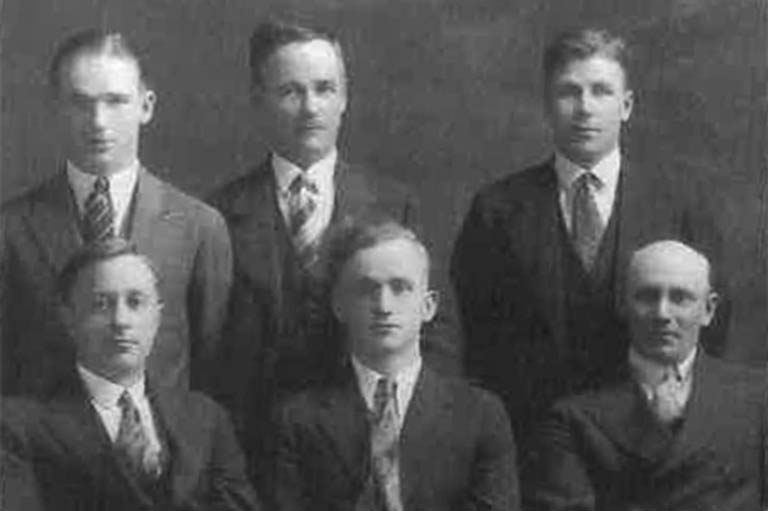Reasonable Doubts
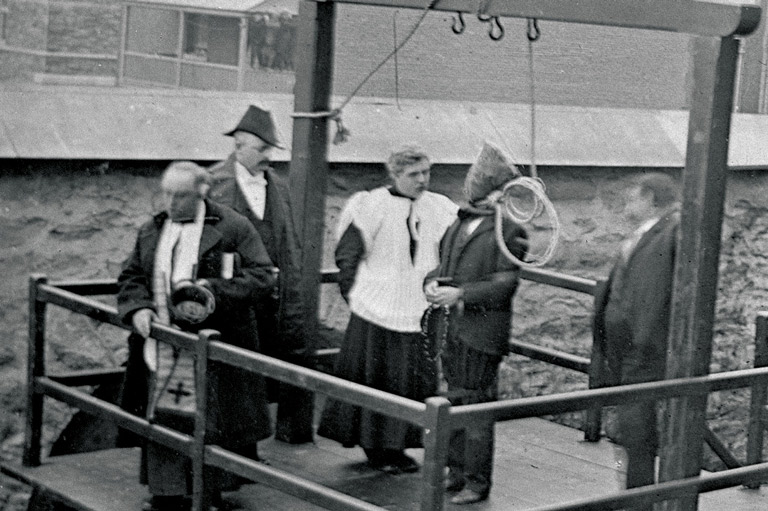
The witnesses called to observe the execution of Cook Teets, a blind man found guilty of killing his wife with strychnine, stamped their feet as they stood at the gate to the Grey County Jail in Owen Sound, Ontario, at dawn on December 5, 1884. A snowstorm was gathering along the shore of Georgian Bay The mixed group of lawyers, doctors, and acquaintances of the condemned man — more than fifty in all — was anxious to have the hanging over and done with.
Just before 8 a.m., Teets, a tall, white-bearded man, emerged from his solitary death cell walking arm-in-arm between two ministers, Methodist Reverend J.E. Howell and Presbyterian Reverend A.H. Scott.
Jailer John Miller led them to the comer of the prison yard where a gallows had been erected.
The doomed man mounted the scaffold with a “firm step,” according to newspaper accounts of the day Dressed in a black broadcloth suit, Teets stood on the trap door waiting to plunge to his death. “Well, gentlemen, this is the fatal board,” he said. Miller would later claim that Teets had intended to confess to the killing. But there was no confession. Church bells tolled a death knell as a black flag was run up the prison’s flagstaff.
The hanging of fifty-five-year-old Cook Teets, the son of a respected family of farmers and furniture makers, was the first ever in Owen Sound. And it left the community divided. The execution followed a long investigation into the death of his bride of six weeks, the former Rosannah Leppard.
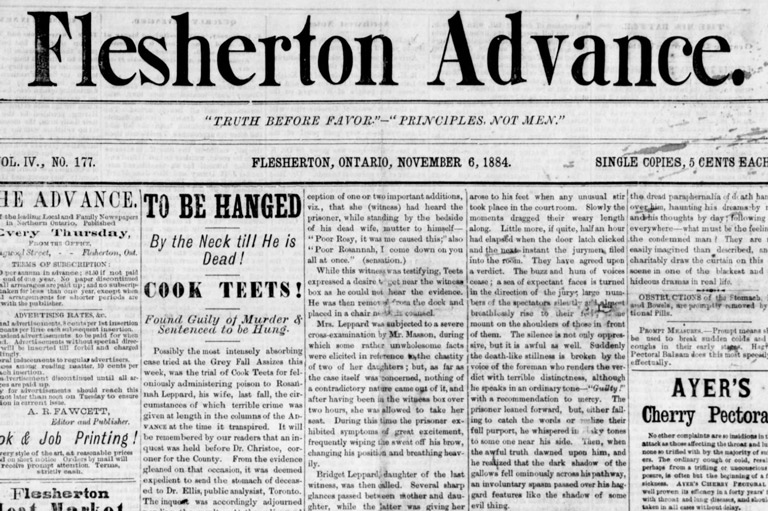
She was just twenty-five and pregnant when a doctor examined her body in the shack where Rosannah still lived with her mother — Teets and Leppard never actually lived together as husband and wife. The home was on the outskirts of Flesherton, a small farm town a few miles south of Owen Sound. An autopsy conducted in Toronto revealed traces of strychnine in her stomach. The jury attending her inquest on November 1, 1883, found her death to have been a “willful murder.” Teets was charged and taken to the Owen Sound jail to await trial.
Many in the community could not believe that Teets — blind since boyhood after being hit in the eyes by a rock-laden snowball — was capable of finding a way to administer a dose of the fast-acting, awful-tasting poison to his young wife Rosie. Neighbours agreed that his behaviour was often eccentric. He had endured the taunts of children as he walked along country roads, led by his faithful seeing-eye dog. But there was evidence that he had not been near his wife for at least twelve hours before her death.
Rosannah belonged to an extended and barely reputable family. Teets had given her money to take out a four-thousand-dollar insurance policy on her life. He said she wanted the policy to provide for any children in the event of her death.
The jury heard only circumstantial evidence against Teets. He admitted having strychnine in his possession — but the pesticide was in common use on this western Ontario farming frontier, mainly to control predators and rodents. Teets explained that he had used some to kill foxes; he had even made a cape for his mother from their pelts.
With 7 uniquely curated newsletters to choose from, we have something for everyone.
Justice J.D. Armour, the presiding judge, charged the jury “strongly against the prisoner,” according to newspaper reports. After a half hour of deliberation, it returned a verdict of guilty, but with a recommendation for mercy.
A total of 168 people signed a petition urging clemency and sent it to Minister of Justice Sir Alexander Campbell, a senator and former law partner of Prime Minister John A. Macdonald. It pointed to “the character of the principal witnesses, namely the Leppard family.” They added it was “quite possible that the poison was obtained by the deceased elsewhere than from Cook Teets or without his knowledge or consent and that it is quite possible that the said poison was administered by some others than the prisoner.”
The petition, along with a second plea sent in by three Owen Sound barristers, went unanswered.
The day before his hanging, Teets dictated a long statement to Reverend Howell. He denied any complicity in the poisoning of his wife, saying simply, “I go to my death an innocent man.”
Was he innocent?
Teets, like most of the 709 other people who have been lawfully executed in Canada, did not have the benefit of such present-day procedures as judicial reviews, public inquiries, DNA evidence, or the support of the group that has been able to overturn many recent convictions, the Association in Defence of the Wrongly Convicted (AIDWYC).
Many who knew Teets believed he was innocent, and later events seemed to prove them right. Those events involved Rosannah’s mother, Roseann Leppard, who was committed to the Toronto Asylum after having served a jail term for attempting to burn down a neighbour’s barn. An 1891 census entry shows her as a resident of the asylum at the age of fifty-five, of Irish extraction, and a Roman Catholic. Apparently suffering from schizophrenia, she remained at the asylum until her death in 1918.
Ten years before Leppard died, she reportedly began telling a strange tale to anyone who would listen. For years, there had been rumours she had had something to do with her daughter’s death. For a time before the arrest of Cook Teets, she had been under surveillance. She had been alone with Rosannah during her daughter’s last meal and was at her bedside while the girl suffered in the throes of poison. She had even gotten a black eye when her daughter struck out before dying.
Now, according to the Toronto Telegram, Leppard had a confession to make. It was she, not Cook Teets, who had poisoned the young woman. The newspaper headlined its story “HANGED AN INNOCENT MAN — Last Execution in Owen Sound Was a Legal Murder.”
Today, Rosannah Teets’ great-great-niece, April Bell, of Abbotsford, British Columbia, believes there is enough doubt about the evidence that Teets should not have been hanged. Bell found out about the case while delving into her family’s genealogy. She came across a story about the incident in a local history book about Artemesia Township. “I knew when I read the page that something didn’t add up, and I was curious to know more,” Bell said recently in an interview.
She read the trial transcript and even visited the cemetery where Teets was buried in an unmarked grave.
“Everything I learned strengthened my conviction that an innocent man had been hanged,” she says. Even so, what really happened is far from clear in her mind. For one thing, she doubts the newspaper account of Roseann Leppard’s confession.
“Roseann Leppard was quite insane for many years, and I have obtained her medical file,” said Bell. “There is no mention in the file that she was confessing to any murder or poisoning. Other ramblings are mentioned quite specifically, so I hesitate to believe this newspaper article. There likely was a lot of rumour for many years....
“So it remains a mystery.”
Save as much as 40% off the cover price! 4 issues per year as low as $29.95. Available in print and digital. Tariff-exempt!
James Lockyer, the criminal lawyer who co-founded AIDWYC, says he has “no doubt that many people were executed in Canada for crimes they did not commit. It’s an inevitable consequence of any system of capital punishment.”
Lockyer, a warm, curly-haired man given to dressing casually in T-shirts and jeans, works out of a spartan office in Toronto’s downtown, where he spends eighty per cent of his time investigating possible wrongful convictions. Sitting at a table cluttered with files and law books, he takes a break from his latest case — a man convicted twenty-three years ago of first-degree murder — to explain why it’s important to examine past miscarriages of justice, even if they happened a long time ago.
There is no way of knowing exactly how many Canadians were put to death for crimes they did not commit.
“It’s always right to find out the truth of any miscarriage of justice. It serves as a warning to Canadians not to go back to capital punishment. Leave that to Iran, China, and the United States.”
He added: “People should care about the history of wrongful convictions, even though it is very difficult to prove innocence beyond the grave.”
There is usually little motivation to try to secure reversals for people who are now dead, says Lockyer. One exception is the case of Wilbert Coffin. On February 10, 1956, a death flag flew and a chime sounded seven times at Montreal’s Bordeaux Jail to mark the hanging of the Quebec mining prospector and woodsman. He had been convicted in the shooting death of Richard Lindsay, one of three American hunters he was thought to have killed. Like Teets, the evidence against Coffin was circumstantial.
Coffin went through seven stays of execution before finally being hanged. His fate sparked great controversy that has never been resolved. Journalist Jacques Hebert, later to become a senator, wrote two books on the case and was cited for contempt of court. Hebert and others who were suspicious of the fairness of Coffin’s trial said his lawyer was incompetent and that the Quebec government applied pressure to obtain a conviction in order to protect the province’s profitable American tourist trade.
With the support of Prime Minister Stephen Harper and Justice Minister Rob Nicholson, Parliament voted on February 6, 2007, for a judicial review of the Coffin case. It is one of fifty-two files being examined by Ottawa’s Criminal Convictions Review Group (CCRG) for new evidence that could warrant a fresh trial or an appeal.
Lockyer’s group has been the driving force in righting the most notorious wrongful convictions in Canada. The list includes the cases of David Milgaard, Guy Paul Morin, Steven Truscott, Clayton Johnson, and Robert Baltovich.
Aside from several political cases where there is general agreement that unjustified hangings were carried out — Louis Riel in 1885, and twelve Patriotes in Quebec following the Lower Canada Rebellion of 1837 — there is no way of knowing exactly how many Canadians, possibly dozens, were put to death for crimes they did not commit.
According to the Department of Justice, while the death penalty was in force in Canada, a total of 1,481 people were sentenced to hang on the gallows. But less than half were actually executed. Others had their sentences commuted to life imprisonment, suggesting the authorities either had concerns about their guilt or at least showed sympathy for their circumstances.
Of those hanged, thirteen were women. And some may have gone to the gallows unjustly, according to criminologists and others who have investigated the cases.
F. Murray Greenwood and Beverley Boissery in their book Uncertain Justice: Canadian Women and Capital Punishment 1754–1953, conclude that at least three women, Julia Murdock, Mary Aylward (read about Mary's case), and Marguerite Pitre (read about Marguerite's case), should not have been hanged. Murdock and Aylward figured in pre-Confederation cases, in both of which a man was also charged.
Murdock, companion-servant to Harriet Henry of Toronto, was hanged for poisoning her employer, while Henry’s husband James, also charged, got off. Mary Aylward was convicted along with her husband Richard for the killing of neighbour William Munro during an altercation over a missing hen on their farm in rural Hastings County.
During the fracas, Richard shot and injured Munro’s son Alexander. Mary came running and hit William with a scythe. Alexander recovered, but his father, who refused medical treatment, died ten days later.
The young husband and wife were hanged side by side in Belleville, Canada West, in 1862 before a rowdy crowd of “old men with whitened locks and bent forms and infants nursing on their mothers’ breasts, young men and maidens, boys and girls, of all sizes and ages” according to the Hastings Chronicle.
Marguerite Pitre came to trial in 1950. Along with Albert Guay, she was accused of planting a bomb on a Canadian Pacific Airlines flight from Quebec City to Baie-Comeau on September 9, 1949. Guay’s wife Rita, along with twenty-two other passengers and crew, died when the bomb went off and the plane crashed. Until the Air India crash of 1985, it was the only case of a plane being brought down by a bomb planted at a Canadian airport.
Pitre told police of the plot when she was rushed to a hospital after having taken an overdose of sleeping pills. She said she tried to commit suicide when, after the plane went down, Guay told her the parcel had held the fatal bomb and that she would be blamed for the explosion. The jury convicted both, along with the man who built the bomb — Genereux Ruest, who was Marguerite Pitre’s brother.
All were hanged on January 9, 1953. Pitre was the last woman to go to the gallows in Canada.
One notable case from the 1930s involved Abraham Steinberg of Toronto, a partner with his three nephews in the Goldberg Bros. Monument Works. Steinberg was alleged to have shot his nephew Samuel Goldberg as Goldberg sat at his desk, and then to have poured coal oil on the body and set the premises alight. The gun was found hidden under a cement bag behind the shop, and witnesses testified it belonged to Steinberg. Tests matched the weapon with the bullets found in Goldberg’s body.
However, three witnesses testified that Steinberg was at a nearby store during the two hours in which the crime could have been committed. A neighbourhood boy, Max Milgrim, supported their testimony but also admitted he had seen Steinberg in the vicinity of the Monument Works.
The jury chose to disbelieve the defence witnesses and instead accepted the testimony of a prisoner who had been held with Steinberg in Toronto’s Don Jail. James Creighton, facing charges of procuring false evidence in a lawsuit, claimed Steinberg had confessed to him. The jury was not told that Creighton had been a patient in a psychiatric hospital, or that the charges against him were withdrawn following his testimony.
After two trials, a failed appeal to the Supreme Court of Canada, and the rejection of a petition signed by 40,000 sympathizers, Steinberg was hanged on July 14, 1931.
In 2007, a team of investigators assembled by AIDWYC started looking into the case of Arthur Lucas, who was hanged back to back with Ronald Turpin at the Don Jail on December 11, 1962. Theirs were the last hangings carried out in Canada.
Lucas, an African-American from Detroit, was convicted on circumstantial evidence in the killing of FBI informant Therland Crater and Crater’s prostitute companion, Carolyn Newman. Turpin was found guilty of shooting Constable Frederick Nash while fleeing a robbery.
AIDWYC’s Win Wahrer says the group began its investigation in response to an appeal from Lucas’s son, Larry Conway. She has so far collected seventeen hundred pages of documents and is seeking another twenty pages withheld by the Ontario Archives. “Disclosure is always an uphill fight in these cases,” she said. There is speculation that Lucas’s low intelligence and a questionable defence by Ross McKay, a lawyer given to heavy drinking, may have contributed to a miscarriage of justice.
Debate over capital punishment had been mounting in Canada for years before the Lucas-Turpin hangings. Their executions ratcheted up the arguments.
Parliament had first discussed abolition in 1914. Public revulsion over the unintentional decapitation of Thomasina Sarao — her head separated from her body when she was hanged in 1935 — added emotion to the debate. A moratorium was declared in 1967, and Parliament finally voted to abolish capital punishment in 1976. However, the death penalty was still on the books in the military until 1998.
In recent years, support for capital punishment has surged in Canada, perhaps influenced by a recent spate of federal government anti-crime bills. Approval for the death penalty, at a record low of forty-four percent in 2005, stood at sixty-two percent in a 2010 Angus Reid poll. The same poll showed support for capital punishment in the United States at eighty-four percent.
Most wrongful convictions, according to one analysis, result from mistakes by witnesses or witness perjury, the negligence of prosecutors, or errors in forensic science. Canada has seen too many innocents condemned — to hanging in the past and life imprisonment in the present — for capital punishment to make a comeback in the twenty-first century.
Counting the cost of compensation
Steven Truscott: Convicted in 1959 for the killing of Lynne Harper. Sentenced to be hanged, later commuted to life imprisonment. Served ten years. Received $6,500,000.
David Milgaard: Convicted in 1970 of the murder of Gail Miller. Sentenced to life. Served twenty-three years. Received $10,000,000.
Donald Marshall: Convicted in the death of Sandy Seale in 1971. Sentenced to life. Served eleven years. received $1,500,000.
Thomas Sophonow: Convicted of the 1981 killing of Barbara Stoppel. Sentenced to life. Served three years, nine months. Received $2,600,000.
James Driskell: Convicted of killing of Perry Harder. Sentenced to life in 1991. Served thirteen years. Received $4,000,000.
Guy Paul Morin: Convicted in the 1984 death of nine-year-old Christine Jessop. Sentenced to life in 1992. Served eighteen months. Received $1,250,000.
Clayton Johnson: Convicted of murdering his wife Janice. Sentenced in 1993 to life. Served five years. Received $2,500,000.
These walls can talk
A curator uncovers evidence of a hanged man many believed was innocent. by Wendy Kitts
Like a Maritime Indiana Jones, Don Alward’s passion for history led him on a quest to uncover the secrets of the Albert County Gaol. The manager and curator of the Albert County Museum in southeastern New Brunswick had always wondered what lay beneath the galvanized metal that covered the walls of two of the three cells in the historic jail. One hot day in August 2008 he decided to find out.
The jail, built in 1845, was undergoing restoration. A work crew was about to paint the walls of the largest cell. It was Alward’s last chance. He carefully loosened and peeled back a section of metal and found scratched into ancient plaster an etching of a woman’s legs, along with a date — August2, 1905. He was thunderstruck.
“I stood there and stared,” remembers Alward. “The first thought that went through my head was, ’That was here when Tom was here.’”
Thomas Francis Collins was the jail’s most notorious prisoner — the only person in the history of Albert County ever sentenced to hang.
Collins, of Irish descent, was fresh off the boat from England in 1906 when he was hired by the local priest as the rectory’s handyman. Just days later, the twenty-two-year-old stood accused of the brutal slaying of the priest’s housekeeper, Mary Ann McAuley.
It took three trials to secure a conviction in a case that deeply divided the community.
“A lot of people thought he was innocent even after he was executed,” said Kenneth Saunders, who wrote about the case in the The Rectory Murder: The Mysterious Crime That Shocked Turn-of-the-Century New Brunswick. “No confession. No witnesses. No forensic evidence. So you can always make a case for circumstantial, but the evidence was pretty strong.” Saunders believes the court made the right decision. But there are others who even today question Collins’ guilt. Alward is among them.
“In today’s courts it would have been thrown out because of too many doubts,” said Alward.
The Collins case is believed to be the first time in Canada someone was tried three times for the same murder. His first trial produced a guilty verdict, which his lawyer successfully appealed on the basis of biased instructions the jury received from the judge — a Canadian legal precedent that is still cited today.
His second trial resulted in a hung jury that was seven to five in favour of his innocence. The third sent him to the gallows, a sentence even the arresting sheriff, who had befriended Collins, worked to have commuted. Many people had contributed to his defence fund. Collins proclaimed his innocence to the end. Yet the hanging went ahead on November 15, 1907.
A century later, as Alward stared at the newly discovered historic graffiti, he pondered the implications of uncovering more of the jail’s walls. The old plaster was fragile and could crumble into dust. But, he thought, “What if the next piece I took off had Tom Collins’ name under it?”
Alward decided to risk exposing more of the walls. They revealed a treasure trove of graffiti — dates as early as 1871, digits marking off time, initials, names, and poems. There were also sketches of horses, carriages, and ships at full-mast, as well as multiple drawings of women wearing corsets with garter belts and stockings.
The prisoners used pencil, ink, and even charcoal in the form of charred wood from the cell’s wood-burning stove to leave their marks. Many drawings were carved into the plaster with pocket knives.
However, evidence of Tom Collins remained elusive until one October day, nearly three months after the search began. Working alone, Alward unearthed three initials in the windowsill of the smallest cell — “T.F.C.” Alward could hardly believe what he saw.
“Before this, Tom Collins was just one of the stories that was told at the museum,” he explained. “This made me see that he was a real person.”
No further evidence of Collins was found. All the historic graffiti is now safely under Plexiglas and can be viewed by museum visitors.
Andree C. Godin, a project executive with the heritage branch of New Brunswick’s Department of Culture, calls the find a “diverse and fascinating picture of life in the jail. It reminded me of images I once saw carved inside the tunnels at Vimy Ridge.... In both cases you get a snapshot of their daily life.”
Meanwhile, the hanging of Tom Collins remains an emotional topic in Albert County.
“It still divides those of us who live here,” said Alward.
Wendy Kitts is a freelance writer based in Moncton, New Brunswick.
Suggested reading:
Uncertain Justice: Canadian Women and Capital Punishment 1754–1953 by F. Murray Greenwood and Beverley Boissery. Dundurn Press, Toronto, 2000.
Terror to Evil-Doers: Prisons and Punishments in 19th Century Ontario by Peter Oliver. University of Toronto Press, Toronto, 1998.
The Rectory Murder: The Mysterious Crime That Shocked Turn-of-the-Century New Brunswick by Kenneth Saunders.
We hope you’ll help us continue to share fascinating stories about Canada’s past by making a donation to Canada’s History Society today.
We highlight our nation’s diverse past by telling stories that illuminate the people, places, and events that unite us as Canadians, and by making those stories accessible to everyone through our free online content.
We are a registered charity that depends on contributions from readers like you to share inspiring and informative stories with students and citizens of all ages — award-winning stories written by Canada’s top historians, authors, journalists, and history enthusiasts.
Any amount helps, or better yet, start a monthly donation today. Your support makes all the difference. Thank you!
Themes associated with this article
Advertisement
You might also like...

Canada’s History Archive, featuring The Beaver, is now available for your browsing and searching pleasure!

